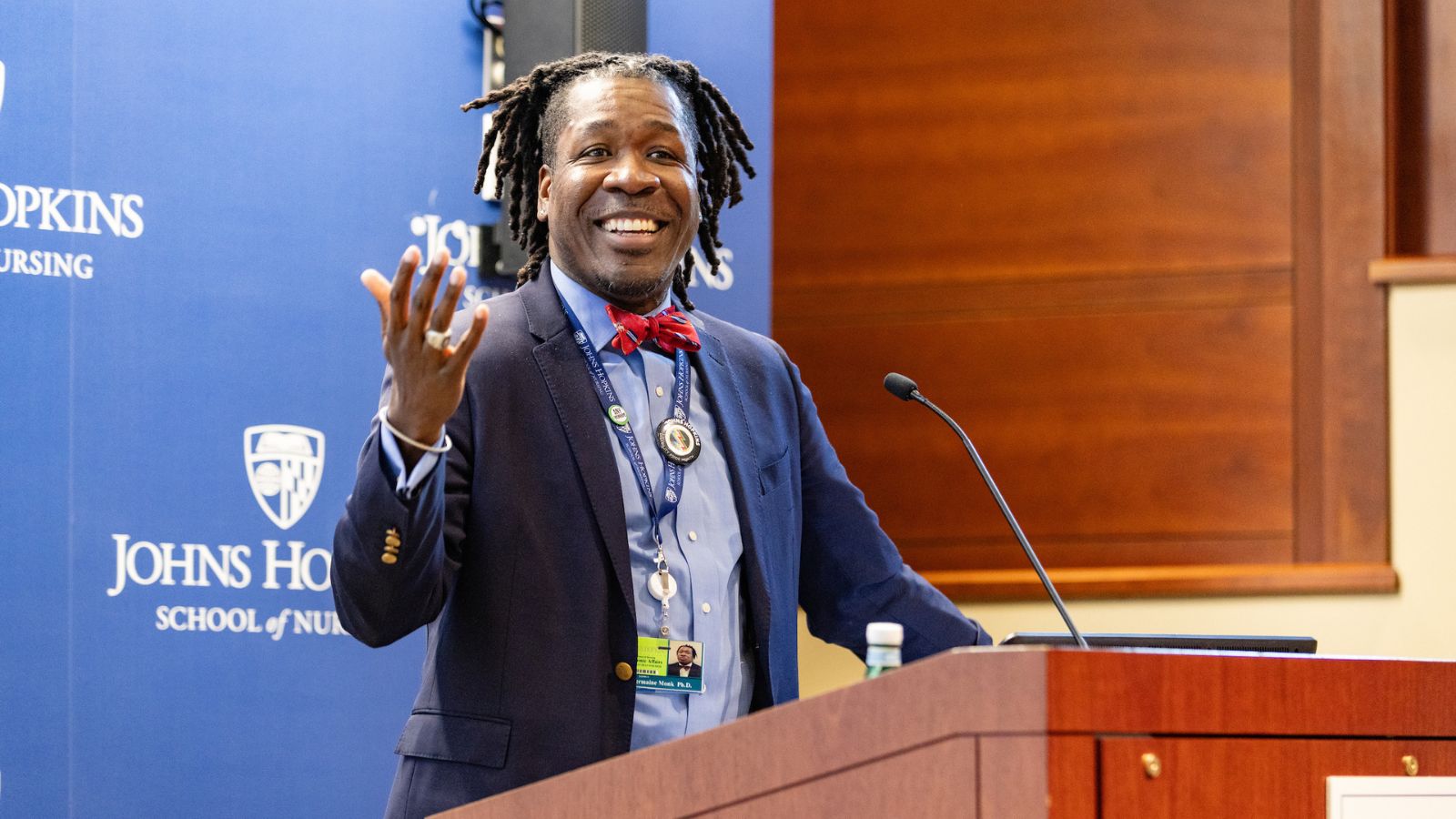Patients, providers, and communities find healing thanks to the nurses who ask “why?”
By Geoff Brown
Illustration by Jesse Kuhn
 In a glass-walled conference room overlooking the grounds of the storied National Institutes of Health in Bethesda, MD, Patricia Grady, PhD, RN – a long-time researcher in stroke and neurological disorders, and director of the National Institute of Nursing Research (NINR) – says that to understand nursing research, you need to understand the special role of nurses.
In a glass-walled conference room overlooking the grounds of the storied National Institutes of Health in Bethesda, MD, Patricia Grady, PhD, RN – a long-time researcher in stroke and neurological disorders, and director of the National Institute of Nursing Research (NINR) – says that to understand nursing research, you need to understand the special role of nurses.
“We are unique,” Grady explains. “We are at the interface of mind and body, of biology and behavior.”
More than any other healthcare profession, nurses are best suited to observe and adjust treatments, medications, and even habits for patients. They can see not just the scientific and medical outcomes but also the human results of treatment, or the emotional behaviors that may lead to the need for treatment. Given that position, nursing research can provide specialized insights and discoveries that other healthcare research might miss.
Sitting in her office at the Johns Hopkins University School of Nursing, Dean Martha Hill, PhD, RN, FAAN, puts it this way: “Nursing researchers ask: What do patients need? What do nurses do to meet those needs? How does that make a difference? To whom? Nurses also look at things important not just to patients and families, but to other members of the healthcare team: physicians, pharmacists, social workers.”
It’s those special traits, abilities, and roles that give nursing research a new and important role in the evolution of healthcare in America. Nursing research has begun to take advantage of a vast body of experiential and evidence-based knowledge and wisdom and curiosity amassed by nurses working with patients in all sorts of settings.
“Nursing research is being partnered with other healthcare research as a critical part of the larger healthcare picture,” says Grady. “There’s a new focus on prevention, and on interaction with the patient, which is the natural environment for nurses.”
“Nurses see the breadth of experiences and are aware of the need to look comprehensively not only at physiological factors but at psychological, social, and emotional factors – the broader determinants of health,” says Dean Hill. “It’s marvelous multidisciplinary work.”
A Growing Discipline
The modern focus on multidisciplinary healthcare research has meant that the groundbreaking and critical work of nurses is now being celebrated in a way that would have seemed impossible just a few decades ago.
“I think research was a foreign concept to nurses,” says Dean Hill. “Thirty years ago, the term ‘nursing research’ was snickered at. It was considered an oxymoron. ‘Why would nurses do research?’ There were no courses for research design in undergraduate nursing school.”
By the 1980s, however, Dean Hill says “that all began to change.” Johns Hopkins University opened its School of Nursing in 1984; Hill was one of the first faculty members, and laughs that she made up about 50 percent of the entire research faculty in those early days. Despite that small beginning, the School of Nursing had a clear mission: It was being developed to follow the rigorous and challenging model followed by the School of Medicine and School of Public Health.
“When we started, we had explicit expectations that the School of Nursing would meet the exacting standards of all the other Johns Hopkins schools,” Dean Hill says. “Johns Hopkins is a research intensive, international institution, and that’s what the School of Nursing has become. The first 10 years, we focused on developing a curriculum; the second decade, we built a research infrastructure. Today, my mandate is to continue to move the school forward as a research intensive, internationally-recognized school.”
Scott Zeger, PhD, vice provost of research for Johns Hopkins, explains that “at Johns Hopkins, we believe that education is inextricably tied to discovery. Unlike many schools of nursing, ours has built its own research infrastructure. They have a research office that’s really admired and envied across the university.”
As healthcare research has changed to encompass more disciplines and experts from different fields, it’s becoming standard practice for Johns Hopkins research teams to include researchers from the schools of Medicine, Nursing, and Public Health. “The School of Nursing is a force for broadening the perspective on health,” Zeger continues, “and it’s common at Johns Hopkins to involve faculty from all three schools.”
“Nursing is at the table now because other healthcare practitioners understand how much it has to offer,” Grady says. Why is that? “We’re in touch with real world issues.”
“We all have different roles, and the nurses’ role and responsibility is different from the physicians, social workers, and physical therapists,” says associate professor Nancy Glass, PhD, MPH, RN, FAAN. “But when I talk to a patient, I’m thinking about that team approach. When I talk to a victim of domestic violence, and she’s going to a shelter, a physician may be thinking about treating the physical injuries. I’m thinking, ‘OK, how do we get her medications to the shelter? How do we get her kids to school?'”
“There’s nothing like a modicum of sense,” says Grady. “We are in a unique position to partner changes in physiology with changes in behavior.”

Encouraging Tomorrow’s Investigators
A normal career track might go like this: the student attends undergraduate nursing school; then goes on to do five or so years of clinical work; then returns to school for a master’s; then heads back into the workforce. In the past, PhD candidates were often in their 50s – which doesn’t leave much time for a research-based academic career. The previous generation of nurses saw PhD-level nursing research as a completely different option than pursuing a long working career helping patients.
That’s not true anymore, says Grady. “It doesn’t have to be either-or,” she says firmly.
“I can’t tell you how many students have said, ‘Research seems exciting, but I would miss the patients if I went into research,'” explains Marie Nolan, PhD, MPH, RN, FAAN, and director of the Hopkins nursing PhD program. “I have to explain that we don’t do research in our offices! We’re constantly working with patients and clinicians, seeing the problems, and evaluating treatment.”
“The School of Nursing has led the way in developing evidence for why we should do specific things in clinical practice,” says Glass. “We go out into the community to improve their health. We feel comfortable outside the ivory tower of academics.”
Some nurse researchers – like Gayle Page, DNSc, RN, FAAN, director of the Center for Nursing Research and Sponsored Projects – even take what nurses have learned from patients and observation and use traditional lab methods to try to recreate and study problems that have no other way of being studied, like pain management. In her work, “there’s a continuum of translation from bench to bedside. I use animals to model pain – it’s reverse translation from patient information. I get the ideas from patients, and I translate it to animals.”
Whether conducted in patient homes, communities, or in the laboratory, says Nolan, the key to increased understanding about nursing and interdisciplinary research is exposing young nurses earlier in their careers. At Hopkins, baccalaureate nursing students take a required course in nursing research, and an Undergraduate Research Honors Program allows a select group to conduct their own research projects under the guidance of a faculty mentor.
Back at the NINR offices and labs in Bethesda, Patricia Grady is also “encouraging the young undergraduate to get involved early and to start doing research early.” It’s a message that she is pushing out into the larger nursing world: “It’s fun to notice a problem and ask questions – that quest for making things better. A curious mind is the thing you most need.”
 Forging Policy: How Can Doulas Improve Black Maternal Health?
Forging Policy: How Can Doulas Improve Black Maternal Health? Forging Policy: Associate Dean Jermaine Monk and Education After Affirmative Action
Forging Policy: Associate Dean Jermaine Monk and Education After Affirmative Action My First Teachers in Nursing School Weren’t Nurses
My First Teachers in Nursing School Weren’t Nurses Most People Want to Breastfeed, But Need More Support To Do So
Most People Want to Breastfeed, But Need More Support To Do So Awards for Diversity
Awards for Diversity






